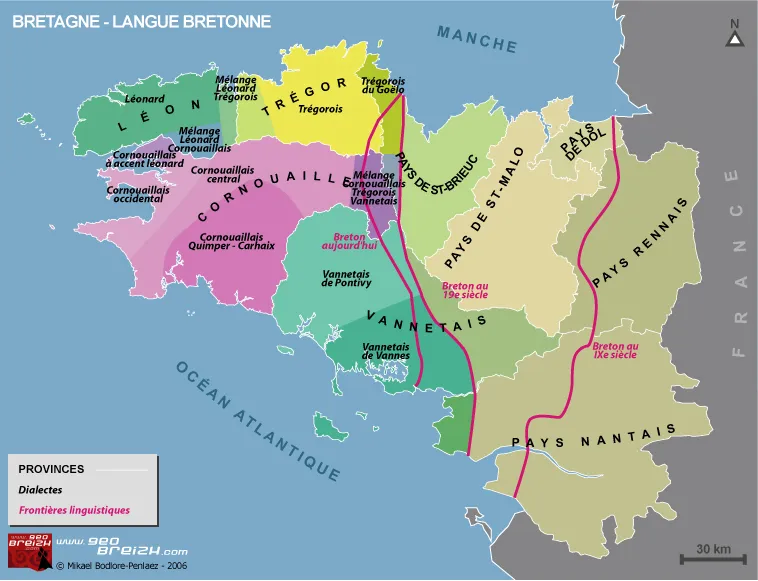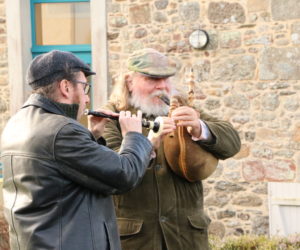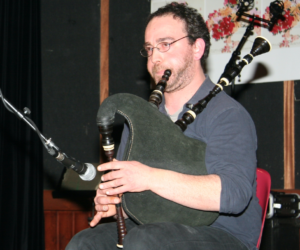Breton music
Credit to Hoëla Barbedette, Feb. 2023
Historical background
Brittany — Bretagne in french, Breizh in the breton language — is a peninsula on the western coast of France. It was a duchy, attached to France in the 16th century. Actually, 4,8 million people live in the five « départements » of historic Brittany (Finistère, Côtes d’Armor, Morbihan, Ile-et-Vilaine and Loire-Atlantique, department that doesn’t belong to the administrative Brittany).
Three languages are spoken in Brittany. French is the main language now, but two vernacular languages still remain : the breton, which is a Celtic language, historically spoken on the western part, and the gallo (latin-based language, dialect of french) on the eastern part.

The most well-known book of Breton collected folk-song is the « Barzaz Breiz », published by Théodore Hersart de La Villemarqué in 1839. Other mains collectors followed, as François-Marie Luzel, Paul Sébillot, Maurice Duhamel… The end of the 19th century and start of the 20th were the beginning of the regionalist and folkloric movement (with the first « cercles celtiques », i.e. folkloric dances group) — mostly in the elite and in Paris. In the 50s, the ancient rural « veillée » (evening), gathering the hamlet inhabitants after the fieldworks around tales and songs to listen or to or dance, as well as, probably, the « bals clandestins » (illegal bals) organized during the second world (war which enabled old singers and circle dances to have a second life), led to the invention of the fest-noz. A fest-noz, or fest-deiz when it is organized during the day, is a typical breton dance evening with singers, instrument players or bands playing alternatively on stage, and 100 to 1000 (sometimes more) people dancing, talking and having a drink at the « buvette ». Breton music and dances, probably more lively than the language, are still very popular in Brittany, but the two « golden periods » were the revival of the seventies and the wave of the nineties. Nowadays, thousands of Bretons are playing their traditional music (and often Irish music too, for the Ireland inspires a lot the Breton culture) as a hobby, and hundreds as a permanent job.
Genres
Dance music takes a big part in the breton musical corpus. The Breton dances are mainly circle dances, inherited from Middle-Age : gavotte montagne, plinn, gavotte fisel, an dro, hanter dro, laridé 8 temps, ridée 6 temps, kost ar c’hoat, rond de Loudéac, rond de Landéda, pilé-menu, passepied… All those dances may be sung or played instrumentally. The singing of the gavotte and the plinn is called the kan-ha-diskan, typical breton « call and response » singing. The quadrilles reached only the eastern part of the peninsula (becoming a lot of avant-deux of different kinds), and couple dances — called « kof-ha-kof » (litterally « belly to belly ») in breton, dances forbidden by the religion like polka,
mazurka, scottiche, waltz — spread quite late, in the start of the 20th century, mostly. Amongst dance music, a lot of different genres exist, like gwerz (in breton) and complainte (in french) which are the epic narrative songs, but also sung or played marches and tunes for the wedding, and other circumstantial songs, from lullabies to sea chanties… Breton sacred music (Brittany has a catholic heritage) is still to listen at churches or during the annuals pardonioù.
Organology
The 18th and mostly the 19th centuries are the great period of the bombard and biniou couple. The bombard is a kind of very loud oboe, comparable to Turkish zurna, and the biniou is a typical Breton small bagpipe, tuned one octave higher than the bombard. Sometimes a drummer is added to the couple.

The biniou & bombard were played in the west and the south parts of Brittany, while the fiddle and hurdy-gurdy were played on the northern coast and the eastern part. On the south-east of Brittany, around Nantes, was played (and had been « re-activated ») a special bagpipe called the veuze.

After the first world war, those instruments were in rivalry with, if not replaced by, the clarinet (called « treujenn-gaol » in breton and « tronc d’choux » in french, both meaning cabbage trunk), followed by the accordion (both chromatic and diatonic) and the saxophone.
After the second world war, the revival brought new instruments, some borrowed the the Celtic nations : Scottish bagpipe, Irish harp, wooden Irish flute, but also guitar, bass, drums… The bagad, kind of marching-bands gathering several bombards, Scottish bagpipes and drums, like a pipe band, was invented in the 50s and has become extremely popular all around Brittany since.
Some reference singers, instruments players or bands :
- Masters from the tradition
Here is a selection of some treasures within the archives collected by the organisation Dastum : see also the emblematic singers the Soeurs Goadec, the frères Morvan, Loeiz Ropars, or bombard player Gus Salaün.
- Emblematic artists or bands from the revivalism (70s to 90s)
Alan Stivell (b. 1944), is a singer and harp player who played a leading role in the seventies folk revivalism in Brittany and, in fact, all around Europe. His concert at the Olympia in 1972 is a key date in Breton music.
Guitarist Dan Ar Braz (b. 1949) did also a lot for the media coverage of Breton music — see his big concert « L’héritage des celtes », which helped launch the 90s and 2000s wave.
Barzaz, around the singer Yann-Fañch Kemener (1957-2019), and Gwerz, around the singer Erik Marchand (b. 1955), are the two concerts band which still inspire the most actual musicians.
Anne Auffret (b. 1949) is one of the great voices of Brittany, here singing the hymn « ar Baradoz », accompanied by bombard player Jean Baron and organ player Michel Guesquière.
Roland Becker (b. 1957) is a very creative bombard player and bands leader.
Kristen Nogues (1952-2007) was probably the most interesting Breton harp player.
Ar re yaouank ( « the youngsters ») was the best known fest-noz band in the 90s, followed by thousands of dancers every Saturday evening — and sharing the stage with other bands, Sonerien Du, Carré Manchot, Gwenfoll, Pennoù-Skoulm, Loened Fall, BF15, Bleizi Ruz…
Denez Prigent (b. 1966) as well as Annie Ebrel (b. 1969) are singer whose careers started in the 90s.
- Current breton scene
Hamon-Martin quintet is currently one of the most appreciated fest-noz band, with Fleuves or the singers of Barba loutig.
Bombard and biniou player Lharidon & Nédélec were the winners of the « couple de sonneurs de bombarde et biniou » championships over the last years.
Krismenn (b. 1981), mixes Breton traditional singing with urban music(s).
The Kreiz Breizh Akademi, project led by Erik Marchand, is a kind of music high-school that trains every two years an orchestra of 10 to 16 musicians exploring Breton music in a very modal way. Each band is really interesting to listen.Here the 8th, for example.
- Some useful websites and links
The website of Dastum, organisation that centralized since 1972 almost all the recordings collected in Brittany and now brings them together on the web.
The page talking about the fest-noz on the UNESCO website (in english).
Kan.bzh, a portal on oral singing tradition in Brittany (with english translations !)
Kenleur, organisation gathering the dance groups and dance schools, puts a lot of informations and tutorials on its website.
Breizh music, an online academy to learn Breton music.
Two very well supplied youtube channels on Breton music, with fest-noz or concerts videos : Tristan Gloaguen’s channel and Avelenn
The Tamm kreiz website, announces all the festoù-noz, concerts, festivals and workshops !
- Reference books
Call to the dance, by Irish musician and ethnomusicologist Desi Wilkinson
La tradition populaire de danse en Basse-Bretagne, 1963, Jean-Michel Guilcher (1914-2017) => on traditional dance, a master-piece work.
Musique Bretonne, histoire des sonneurs de tradition (collectif, 2003) => a reference work on the traditional musicians.
All books published by Datsum are excellent work.
- Documentary films
A portray of an old singer, Marcel Guillou
A film showing three different fest-noz all around Bretagne
A portray (in breton subtitled in French) of well-known singer Yann-Fañch Kemener
« Avec Dédé » is also a great portray of bombard player Dédé Le Meut, showing the great person he is but also the very different contexts in which he is playing.